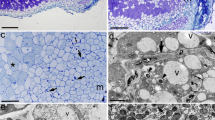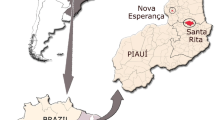Abstract
The root nodules of two wild legume species endemic to Algeria, Hedysarum naudinianum and He. perrauderianum, were investigated with regard to their anatomy and histology, and the identity of the associated bacteria. Both plants were found to form root nodules with regular features and well infected by rod-shaped bacteria. The culturable fraction of bacteria that could be obtained from surface-sterilized nodules included a prevailing presence of Enterobacteriaceae having 100 % 16S rDNA sequence identity with both Enterobacter cloacae and E. ludwigii. In H. perrauderianum, this taxon was the sole cultured isolate, while from H. naudinianum we also found Bacillus, Lactobacillus, Staphylococcus, Rothia, and isolates that were 100 % identical to Corynebacterium pseudodiphthericum, which is known to be an agent of respiratory and cardiac infections in humans. Whereas no culturable rhizobia and alike could be obtained on plates, PCR-based culture-independent approaches revealed in both plants the presence of a Mesorhizobium sp., which in H. perrauderianum was identical to isolates nodulating other legumes from Africa, European Mediterranean countries, and Asia, while in H. naudinianum it bore a single nucleotide polymorphism which is so far unique for any observed mesorhizobia. Data from the microsymbionts appear to suggest interesting clues to interpret the evolutionary ecology of their host plants.



Similar content being viewed by others
References
Abdelguerfi-Berrekia R, Abdelguerfi A, Bounaga N, Guittonneau GG (1988) Contribution à l’étude des espèces spontanées du genre Hedysarum L. en Algérie. I- Etude auto écologique. Ann Inst Nat Agro El-Harrach 12:191–219
Abdelguerfi-Berrekia R, Abdelguerfi A, Bounaga N, Guittonneau GG (1991) Répartition des espèces spontanées du genre Hedysarum selon certains facteurs du milieu en Algérie. Fourrages 126:187–207
Altschul SF, Gish W, Myers EW, Lipman DJ (1990) Basic local alignment search tool. J Mol Biol 215:403–410
Aspiroz Sancho C, Agustín Berne A, Navarro Pardos C, Sañudo Blasco B, Teller JP (2002) Pneumonia caused by Corynebacterium pseudodiphteriticum, an entity worth knowing. An Med Interna 19:463–465
Beck DP, Materon LA, Afandi F (1993) Pratical Rhizobium- Legume Technology Manual. ICARDA, Syria
Benhizia Y, Benhizia H, Benguedouar A, Muresu R, Giacomini A, Squartini A (2004) Gamma proteobacteria can nodulate legumes of the genus Hedysarum. Syst Appl Microbiol 27:462–468
Choi BH, Ohashi H (2003) Generic criteria and infrageneric system for Hedysarum and related genera (Papilionoideae e Leguminosae). Taxon 52:567–576
Dijken B, Van Wermeskerken J, Beute A (1950) Subacute bacterial endocarditis, probably caused by Corynebacterium pseudodiphthericum (Hofmann's bacillus). Ned Tijdschr Geneeskd 94:2081–2088
Elvira-Recuenco M, van Vuurde JWL (2000) Natural incidence of endophytic bacteria in pea cultivars under field conditions. Can J Microbiol 46:1036–1041
Gorricho J, Cruz Villuendas M, Remacha MA, Seoane A (1996) Pneumonia by Corynebacterium pseudodiphthericum. Enferm Infecc Microbiol Clin 14:632–633
Gutiérrez-Rodero F, Ortiz de la Tabla V, Martínez C, Masiá MM, Mora A, Escolano C, González E, Martin-Hidalgo A (1999) Corynebacterium pseudodiphtheriticum: an easily missed respiratory pathogen in HIV-infected patients. Diagn Microbiol Infect Dis 33:209–216
Klironomos JN (2002) Feedback with soil biota contributes to plant rarity. and invasiveness in communities. Nature 417:67–70
Marchesi JR, Sato T, Weightman AJ, Martin TA, Fry JC, Hiom SJ, Wade WG (1998) Design and evaluation of useful bacterium-specific PCR primers that amplify genes coding for bacterial 16S rRNA. Appl Environ Microbiol 64:795–799
Muresu R, Polone E, Sulas L, Baldan B, Tondello A, Delogu G, Cappuccinelli P, Alberghini S, Benhizia Y, Benhizia H, Benguedouar A, Mori B, Calamassi R, Dazzo FB, Squartini A (2008) Coexistence of predominantly nonculturable rhizobia with diverse, endophytic bacterial taxa within nodules of wild legumes. FEMS Microbiol Ecol 63:383–400
Muresu R, Maddau G, Delogu G, Cappuccinelli P, Squartini A (2010) Bacteria colonizing root nodules of wild legumes exhibit virulence-associated properties of mammalian pathogens. Antonie Van Leeuwenhoek 97:143–153
Muresu R, Polone E, Sorbolini S, Squartini A (2011) Characterization of endophytic and symbiotic bacteria within plants of the endemic association Centaureetum horridae. Mol Plant Biosyst 145:478–484
Osborn AM, Moore ERB, Timmis KN (2000) An evaluation of terminal-restriction fragment length polymorphism (T-RFLP) analysis for the study of microbial community structure and dynamics. Environ Microbiol 2:39–50
Ourarhi M, Abdelmoumen H, Guerrouj K, Benata H, Muresu R, Squartini A, Missbah El Idrissi M (2011) Colutea arborescens is nodulated by diverse rhizobia in Eastern Morocco. Arch microbiol 193:115–24
Quezel P, Santa S (1962) Nouvelle flore de l’Algérie et des régions désertiques méridionales. CNRS, Paris
Squartini A, Struffi P, Döring H, Selenska-Pobell S, Tola E, Giacomini A, Vendramin E, Velázquez E, Mateos PF, Martínez-Molina E, Dazzo FB, Casella S, Nuti MP (2002) Rhizobium sullae sp. nov. (formerly ‘Rhizobium hedysari’): the root-nodule microsymbiont of Hedysarum coronarium L. Int J Syst Evol Microbiol 52:1267–1276
Tondello A, Villani M, Alessandrini A, Baldan B, Squartini A (2011) Identification of the root nodule symbiont of the rare legume species Hedysarum confertum Desf. (Hedysarum humile L.) in its Italian relictual site. Plant Biosytems 145:901–905
Trifi-Farah N, Marrakchi M (2001) Hedysarum phylogeny mediated by RFLP analysis of nuclear ribosomal DNA. Gen Res Crop Evol 48:339–345
Trifi-Farah N, Baatout H, Boussaid M, Combes D, Figier J, Hannachi-Salhi A, Marrakchi M (2002) Evaluation des ressources génétiques des espèces du genre Hedysarum dans le bassin méditerranéen. Plant Genet Resour Newslett 130:1e6
Vincent JM (1970) The manual for the practical study of root nodule bacteria. Blackwell, Oxford
Author information
Authors and Affiliations
Corresponding author
Rights and permissions
About this article
Cite this article
Torche, A., Benhizia, H., Rosselli, R. et al. Characterization of bacteria associated with nodules of two endemic legumes of Algeria, Hedysarum naudinianum and H. perrauderianum . Ann Microbiol 64, 1065–1071 (2014). https://doi.org/10.1007/s13213-013-0745-3
Received:
Accepted:
Published:
Issue Date:
DOI: https://doi.org/10.1007/s13213-013-0745-3




